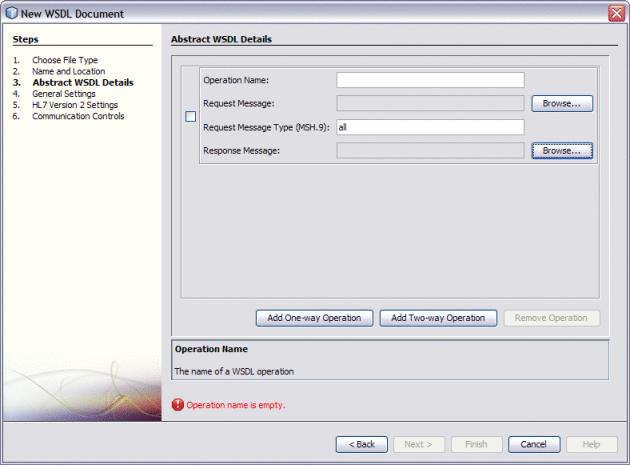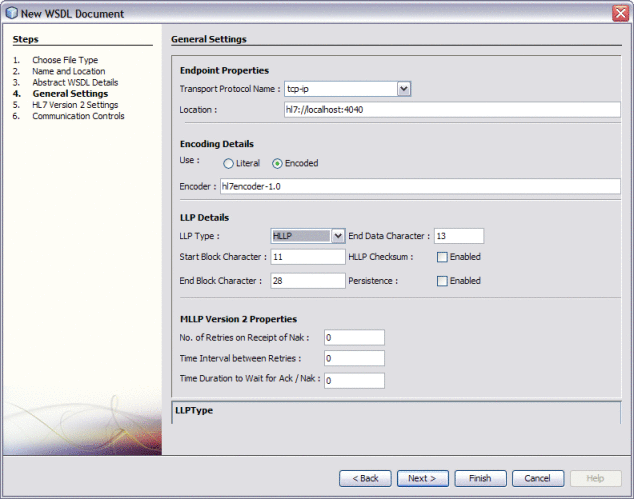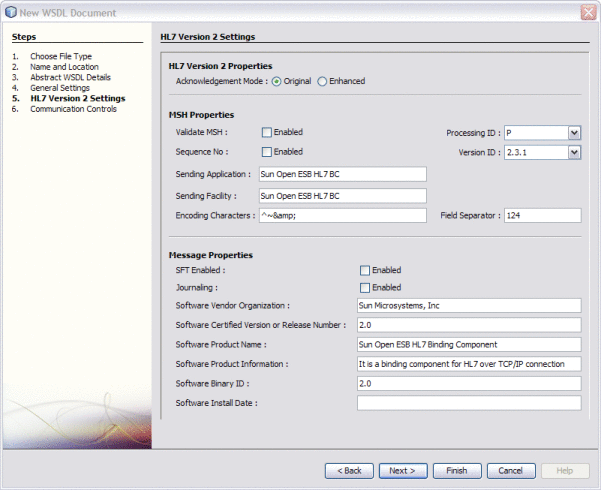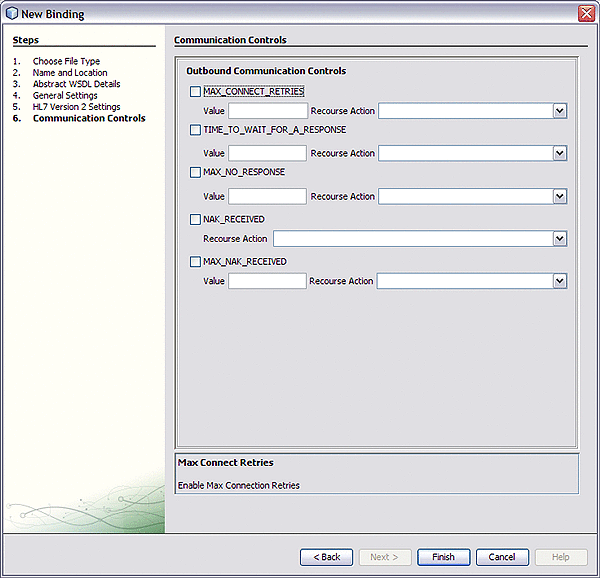Using the HL7 Binding Component Wizard
The HL7 Binding Component is similar to other binding components in that you use a wizard that steps you through creating the binding WSDL document. Each of these processes bring you to the HL7 Binding Component Wizard.
Note –
There are two types of WSDL documents. The Concrete WSDL Document option is the only way to create an HL7 Binding Component.
-
Abstract WSDL Document: An XML document that contains interface information that defines the structure of the method input properties, returned output types, exceptions or fault types, and the port type or interface. It does not contain any concrete data structures such as transport protocols or network address locations. The abstract type only requires that you fill out the Abstract Configuration page of the wizard.
-
Concrete WSDL Document:An XML document that includes the bindings to protocols, concrete address locations and service elements, along with the abstract WSDL information. The concrete type requires you to select a Binding and a Binding Type. Additional configuration pages are added to the wizard, associated with the binding and type you select, in this case, the HL7 Binding.
The following topics provide information and instructions for accessing and using the HL7 Binding Component Wizard:
Accessing the HL7 Binding Component Wizard
You can access the HL7 Binding Component Wizard and create an HL7 binding by performing any of the following procedures.
 To Access the Wizard by Creating a New File
To Access the Wizard by Creating a New File
-
Select your project in the NetBeans IDE Projects window, then click the New File icon, or select File -> New File from the NetBeans menu.
Ctrl+N also opens the New File Wizard.
-
Select ESB as the Category, and select Binding as the File Type.
-
Click Next.
The Name and Location window appears.
-
Enter a name for the BC, select HL7 in the Binding field, and select the type of HL7 binding in the Type field (inbound or outbound).
-
If necessary, you can also modify the Folder and Target Namespace fields.
The target namespace is the URL String used as the target namespace.
-
Continue to Configuring the HL7 Binding Component in the Wizard.
 To Access the Wizard by Creating a New Binding
To Access the Wizard by Creating a New Binding
-
Right-click your project in the Projects tree, and select New -> Other.
The New File Wizard appears.
-
Select ESB as the Category, and Binding as the File Type.
-
Click Next.
The Name and Location window appears.
-
Enter a name for the BC, select HL7 in the Binding field, and select the type of HL7 binding in the Type field (inbound or outbound).
-
If necessary, you can also modify the Folder and Target Namespace fields.
The target namespace is the URL String used as the target namespace.
-
Continue to Configuring the HL7 Binding Component in the Wizard.
 To Access the Wizard by Creating a New WSDL
Document
To Access the Wizard by Creating a New WSDL
Document
-
Right-click your project in the Projects tree, and select New -> WSDL Document.
The New WSDL Document Wizard appears.
-
Enter a File Name, and select Concrete WSDL Document as the WSDL Type.
This adds additional options to the wizard.
-
In the Binding field, select HL7; and in the Type field, select the type of HL7 Binding you want to create (inbound or outbound).
-
If necessary, you can also modify the Folder and Target Namespace fields.
The target namespace is the URL String used as the target namespace.
-
Continue to Configuring the HL7 Binding Component in the Wizard.
Configuring the HL7 Binding Component in the Wizard
From the HL7 Binding Component Wizard you can configure an inbound or outbound HL7 Binding Component. The HL7 Binding Component supports the following types of binding:
-
Inbound Request: A request message and MSH.9 field type, and inbound communication controls.
-
Inbound Request Reply: A request message and MSH.9 field type, response message, and inbound communication controls.
-
Outbound Request: A request message and outbound communication controls.
-
Outbound Request Reply: A request message, a response message, and outbound communication controls.

 To Configure the HL7 Binding Component in
the Wizard
To Configure the HL7 Binding Component in
the Wizard
-
Complete one of the procedures under Accessing the HL7 Binding Component Wizard.
You should now be on the Name and Location window of the New WSDL Document Wizard, shown above.
-
Click Next.
The Abstract WSDL Details window appears.

-
Do one of the following:
-
To implement an inbound or outbound request operation, select Add One-Way Operation.
-
To implement an inbound or outbound request response operation, select Add Two-Way Operation.
The fields to configure the type of operation you chose appear.
-
-
Fill in the abstract WSDL properties as described in Abstract WSDL Properties.
-
Click Next.
The General Settings windows appears.

Note –The image above shows the properties for an outbound binding type. There are fewer fields for the inbound type.
-
Fill in the general settings properties as described in General Settings.
-
Click Next.
The HL7 Version 2 Settings window appears.

-
Fill in the HL7 version 2 settings properties as described in HL7 Version 2 Settings.
-
Click Next.
The Communication Controls window appears.

Note –The image above shows the properties for an outbound binding type. There are fewer properties for the inbound binding types.
-
Fill in the communication controls properties as described in Communication Controls.
-
Click Finish.
The WSDL file is created and appears inn the Projects window. The WSDL Editor appears, displaying the content of the file.
Abstract WSDL Properties
The Abstract WSDL Details page of the wizard specifies the request and response messages and the message type specified as the MSH.9 field value. The options on this page vary depending on the HL7 Binding type. The Response Message Type field only appears for two-way operations.
|
Property |
Description |
|---|---|
|
Operation Name |
A name for the operation in the WSDL document. |
|
Request Message |
The HL7 XSD element or type used for the request message. |
|
Request Message Type |
The HL7 message type that the operation handles. This value should be the same as the message type entered in the MSH.9 field value. |
|
Response Message Type |
The HL7 XSD element or type used for the response message. |
General Settings
The General Settings page of the HL7 Binding Wizard specifies the connection protocol and encoding details. The Outbound HL7 Bindings also include configuration properties for LLP message transport protocols.
The general settings are categorized into the following property types:
Endpoint properties
The Endpoint properties specify the connectivity information to the HL7 external system, and include the following configuration properties.
|
Property |
Description |
|---|---|
|
Transport Protocol Name: |
The transport protocol used to transmit the HL7 message payload. For HL7 v2.X the only current transport protocol option is TCP/IP |
|
Location |
A URL used to connect to the HL7 external system. |
Encoding Details
The Encoding Details specify the concrete properties associated with receiving or sending HL7 messages from or to the HL7 external system. The Encoding Details section include the following properties.
|
Property |
Description |
|---|---|
|
Use |
The use type, which affects how a message is interpreted. The options are Literal or Encoded. The Encoded option specifies that the message is encoded using a well-defined encoding style. |
|
Encoder |
The encoding type associated with the message. This also defines the encoder type used to process the encoded data. |
LLP Details
The LLP Details section defines the Lower Layer Protocol (LLP) used for the HL7 messages, and includes the following properties.
MLLP Version 2 Properties (Outbound Only)
The MLLP Version 2 Properties are for outbound message only, and configure the Minimal Lower Layer Protocol (MLLP) version 2 property. This section includes the following properties.
|
Property |
Description |
|---|---|
|
No. of Retries on Receipt of NAK |
The maximum configured number of attempts to send a message after receiving a negative acknowledgement. |
|
Time Interval Between Retries |
The duration in milliseconds to wait between each retry attempt. |
|
Time Duration to Wait for ACK / NAK |
The duration in milliseconds to wait for MLLP V2 commit positive or negative acknowledgement. |
HL7 Version 2 Settings
The HL7 Version 2 Settings are divided into the following property types:
HL7 Version 2 Properties
The HL7 Version 2 Properties section includes the Acknowledgement Mode property.
MSH Properties
The MSH Properties section provides the HL7 MSH Header segment settings. It includes the following properties.
Message Properties
The Message Properties section contains the SFT configuration settings. HL7 versions 2.5, 2.5.1, and 2.6 add an SFT segment to every message. The binding not only sends and receives messages with the SFT segment, it can automatically create and populate the SFT configuration settings using information from the message properties for outbound mode, and from the ACK sent for inbound mode. This section includes the following properties.
|
Property |
Description |
|---|---|
|
SFT Enabled |
An indicator of whether SFT segment processing is enabled. |
|
Journaling |
An indicator of whether journaling of the HL7 message and ACK is enabled. |
|
Software Vendor Organization |
The Software Vendor Organization field (SFT-1-Software Vendor Organization), which identifies the vendor who is responsible for maintaining the application. This property only applies to HL7 versions 2.5, 2.5.1, and 2.6. |
|
Software Certified Version or Release Number |
The Software Certified Version or Release Number, which is the value of the HL7 segment SFT-02. The current software version number or release number for the sending system, helps to provide a more complete profile of the application that is sending or receiving the HL7 messages. For example, if the sending system is Java CAPS 6.1, the value would be 6.1. This property only applies to HL7 versions 2.5, 2.5.1, and 2.6. |
|
Software Product Name |
The name of the software product that submitted the transaction, which is the value of the HL7 segment SFT-03. The software product name is a key component for identifying the sending application. This property only applies to HL7 versions 2.5, 2.5.1, and 2.6. |
|
Software Product Information |
The software product identification information, which is the value of the HL7 segment SFT-05. This may include a description of the software application, configuration settings, modifications made to the software, and so forth. This information is used for diagnostic purposes to help identify the application software. This property only applies to HL7 versions 2.5, 2.5.1, and 2.6. |
|
Software Binary ID |
The Software Binary ID, which is the value of HL7 segment SFT-04. This property is available starting with HL7 version 2.5. Software Binary IDs are issued by a vendor for each unique software version instance. These IDs are used to differentiate between differing versions of the same software. Identical Primary IDs indicate that the software is identical at the binary level, but configuration settings may differ. This property only applies to HL7 versions 2.5, 2.5.1, and 2.6. |
|
Software Install Date |
The Software Install Date, which is the value of HL7 segment SFT-06. This is the date on which the submitting software was installed at the sending site. The install date can provide key information in regard to the behavior of an application. The date format is YYYYMMDDHHSS. This property only applies to HL7 versions 2.5, 2.5.1, and 2.6. |
Communication Controls
The last page of the HL7 Binding Wizard, the Communication Controls page, provides configuration properties for the communication controls and recourse actions that control the sending and receiving of messages over a TCP/IP connection. These properties are defined by the Communication Control WSDL Extensibility Element, and help establish the Quality of Service (QoS) between the HL7 external system and HL7 endpoints.
The communication controls differ for inbound or outbound endpoints, therefore different pages are provided for inbound or outbound.
The recourse actions supported by the HL7 Binding Component can include the following values:
-
Reset: The binding component closes the connection with the HL7 external system and throws an alert.
-
Resend: The binding component resends the last sent message to the HL7 external system.
-
Suspend: The binding component closes the connection with the HL7 external system, suspends the endpoint from processing the messages, and throws an alert.
-
Skipmessage: The binding component remains connected but writes the message to an error queue.
-
Error: The binding component throws an Exception.
Each property in the table below allows you to enable or disable the control, select a value, and select a recourse action. If you do not enable the control, any setting you configure for that control are ignored.
Table 1 Inbound Communication Controls
Each property in the table below allows you to enable or disable the control, select a value, and select a recourse action. If you do not enable the control, any setting you configure for that control are ignored.
Table 2 Outbound Communication Controls
- © 2010, Oracle Corporation and/or its affiliates
